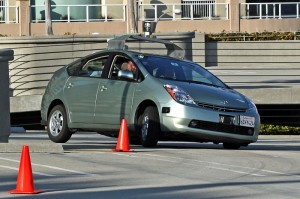Though I’ve always believed that the shortwave spectrum is a medium–a conduit for international communications not simply confined to analog audio broadcasts–I would have never guessed it would be used in an autonomous vehicle technology system. But check this out (and see update/comments below, plus our follow-up post):
(Source: TPM)
Toyota and Audi turned heads earlier this month by announcing that they were following in Google’s tracks and developing partially self-driving, or “autonomous” vehicle technology systems of their own.
At that time, Toyota noted in press materials that it has been testing one such semi-autonomous vehicle system — the Intelligent Transportation System (ITS), which uses short wave radio signals to have cars communicate with other vehicles and surrounding infrastructure to avoid collisions — at a simulated city inside its Higashi-Fuji Technical Center in Susono City, Japan.
Toyota also said that further “research and development will continue at Toyota Research Institute, North America (TRiNA), in Ann Arbor, Mich.” […] Read the full article on TPM.
Update: Sean (@VA5LF) commented on Twitter, “wow, that sounds ill-advised. HF is no place for local area comms!”
I wholeheartedly agree, Sean. The use of LED traffic lights alone bombards my car’s AM radio with Radio Frequency Interference (RFI). I can’t imagine my life depending on a technology that is so vulnerable to RFI. I would assume Toyota has a way to overcome this, else this info is simply incorrect/inaccurate. I mean, imagine how geo storms or skip would effect local driving conditions. 🙂
Reader comments:
One commenter noted:
“I didn’t know that VHF, UHF, or 5.9 GHz bands were considered short wave.”
Then Mike sent a message with the following comment:
I was just reading the posting about Toyota and self driving vehicles and the mention of “short wave radio signals”. I wonder if some how they meant “near field communication (NFC)” and it has been translated to short wave (near field – short distance) radio communication? NFC is a proven technology being used for payment systems etc.
Just wondering aloud.
Indeed. I strongly suspect this journalist got their terminology a little skewed! Check out our follow-up post.


This is genius. It will work every night, just after sundown.
Arch–Ha! Ha!
Thank you, Benn. I must say, I know little to nothing about anti-collision systems. It is odd that Toyota is stating short wave.
What may have happened is that Toyota’s media people confused Short Range with Short Wave. Officially the 5.9 GHz system they referred to is called Dedicated Short Range Communications (DSRC). That’s what the FCC named it when they allocated that band.
The FCC is into dry technical facts and not marketing. DSRC is too geek of a term. The government had to come up with a name that sounded more 21st Century, like Apple invented it or something. So it’s now the awesome Dept of Transportation Service Mark called IntelliDrive.
Most vehicle anti-collision radar development is in the EHF millimeter wave spectrum, especially 76 GHz.
Vehicle to vehicle and road-to-vehicle wireless systems are standardized at 5.9 GHz after FCC action in that band years ago:
http://www.iteris.com/itsarch/html/standard/dsrc5ghz.htm
Toyota’s press materials claim that these are short wave.
I didn’t know that VHF, UHF, or 5.9 GHz bands were considered short wave.
Indeed. I suspect the info in this article is either inaccurate, or the journalist didn’t understand the explanation of how these cars will communicate. As I mentioned in the update, RFI would be a major concern too. Plus, geo storms and skip could make for some interesting driving conditions!